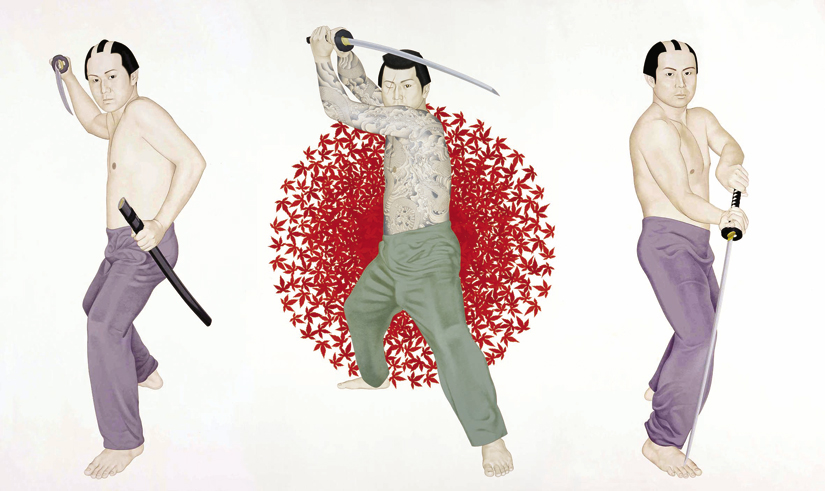Hisashi Tenmyoya "Made in Japan"(TOKYO)
6 September - 7 October 2006
The year 2006 for Tenmyouya has started off with his first exhibition at the domestic art museum: the Museum of Contemporary Art Tokyo “MOT Annual 2006: NO BORDER- From ‘Japanese Paintingユ’ to ‘Japanese Painting'”. Thereafter, there were Official Art Poster 2006 FIFA World Cup Germany, release of his documentary film from the near equal series ‘≒ Tenmyouya Hisashi’, a group exhibition “Berlin-Tokyo/Tokyo-Berlin” at New National Gallery in Berlin, and publication of his third catalogue ‘TENMYOUYA HISASHI’. He has become one of the most remarkable artists who keep delighting our eyes with his dynamic activities.
Tenmyouha Hisashi creates his work with rebellious approach against current tendency as his core of expression that is inherited from robust Bushi spirit of innate Japanese counter culture, “Basara”(*1) of Muromachi period and “Kabukimono”(*2) in Edo period. By executing motifs which often appears in his work: decorated trucks (dekotora), Bosozoku (motorcycle gangs) and Tattoos, and contrasting motifs inspired from Japanese traditional painting with a contemporary new media such as acrylic paint or tracing paper, he juxtapose and merge tradition, challenging the modern world with this unique style he named “Neo-Nihonga.”
The exhibition will contain new works. A large scale painting with three samurais stand against the Japanese flag depicted with autumn leaves titled “Made in Japan” will be its central piece. Other works are tattooed Amitabha of “San-etsu Amitabha”,and colored version of “Transparent Scroll”.
Today the product made in Japan has been approved internationally for its function and good design. The term “Made in Japan” signifies not only a product made in Japan but also as a brand name acclaimed from its quality. Also, there is much in the saying that this word “Made in Japan” holds the essence of frequently used phrase -glocal- “Think Globally, Act Locally.”
As Tenmyouya says, “Being born and raised in Japan, I am proud of Japanese culture and identity. In order to survive in the international art scene, I believe the unique Japanese aesthetic and culture that doesnユt exist in the western context can be a great weapon, ” the stance he takes is fully conscious of being neither a stylish culture nor oversea stereotyped traditional Japanese caused from a rapid internationalization and integration of cultures, but keenly conspicuous “Japanese artist’s work that transcend autochthony, and transmitted to the world from Japan”. By calling himself “Buto-ha” who fights with his paintbrush to throw off the ready-made concept, he quest for the real meaning of “Made in Japan” raising this questions to the audiences.
(*1)A word often used to describe the act of daimyo (feudal lord) during the Nanbeichao unquiet days. Its etymology of Buddhist terminology “Vajra” in Sanscrit means diamond. Its ability to shatter everything turned its meaning to off pitch music and dance, and further extension to act every extravagant way
(*2) A word used to describe a person who has a desire not to remain within secure constraint of the orthodox but to seek change. It derives from a word “kabuku”, to behave as one pleases or wear blatant out fit ” (Kojien) is also etymology of the traditional Japanese theater “Kabuki”.

